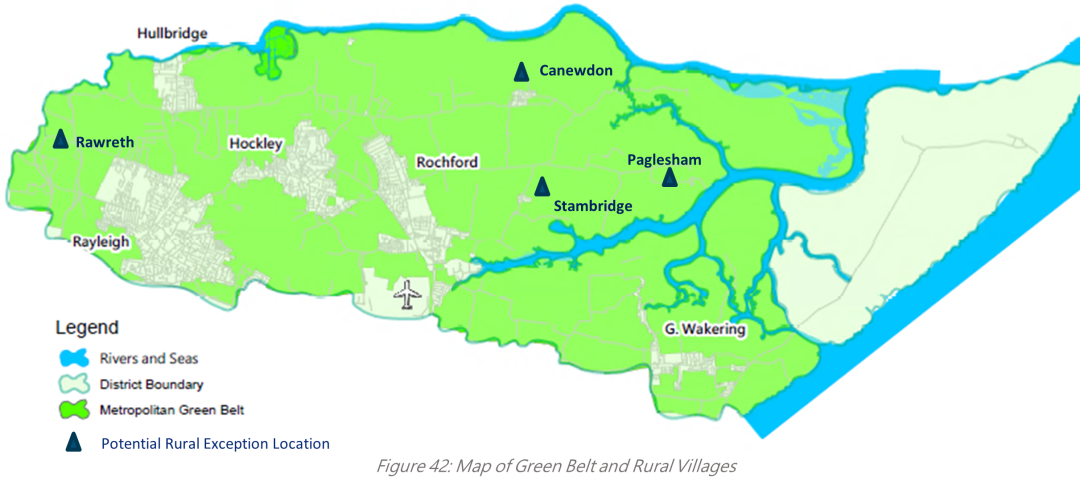New Local Plan: Spatial Options Document 2021
 Green Belt and Rural Issues
Green Belt and Rural Issues
Relevant Plan Objectives: 20
Whilst the majority of Rochford's residents live in urban areas, the vast majority of Rochford's land area is rural in nature. We have an important agricultural heritage and a strong and growing rural economy.
Our rural areas have unique planning challenges compared to urban areas. Our rural communities generally have the poorest access to facilities, as the catchment population is not sufficient to sustain many services, whilst land uses in rural areas are often very different to those in the urban areas, with far more agricultural, horticultural and informal economic activity. Addressing these challenges is made complicated by the fact that the majority of our rural land is designated as part of the Metropolitan Green Belt meaning that new development is generally restricted, save for some exceptions for agricultural and forestry development.

Over 12,000 hectares of our land area is covered by the eastern extent of the Metropolitan Green Belt. The Metropolitan Green Belt is a planning designation that restricts development in areas around cities to prevent urban sprawl and prevent neighbouring towns merging into one another. Green Belt areas of the District which are sensitive for this reason include between Rayleigh and Eastwood, Rayleigh and Hockley, and Hawkwell and Rochford. National policy makes it clear that Green Belt boundaries should only be changed in exceptional circumstances. Before concluding that exceptional circumstances exist to justify changes to Green Belt boundaries, a local authority will need to demonstrate that it has examined fully all other reasonable options for meeting its identified need for development, including to make as much use as possible of suitable brownfield sites and underutilised land; encourage higher densities in existing urban areas and check with neighbouring authorities whether they can accommodate our need for development in their area. Whilst no detailed changes to our Green Belt boundary are being proposed in this consultation paper, it is recognised elsewhere in this document that we are unlikely to have sufficient urban and brownfield sites to meet our need for housing, employment or community facilities, and neighbouring authorities have advised they are unlikely to be able to accommodate any of Rochford's needs themselves. We have therefore completed a Green Belt study to consider the contribution that different parts of our District make to Green Belt policy to inform an assessment of whether exceptional circumstances are likely to exist.
National policy makes it clear that in rural areas, planning policies and decisions should be responsive to local circumstances and support housing developments that reflect local needs. To promote sustainable development in rural areas, national policy encourages housing to be located where it will enhance or maintain the vitality of rural communities. However this needs to be balanced against the likelihood of the housing introducing or sustaining services. It is unlikely, for example, that building a small amount housing in a hamlet will improve the vitality of these communities. However, where there are clusters of smaller settlements in one area, such as to the east of Rochford, it is recognised that managed development in one village may benefit rural communities in a wider area.
Rural exception sites are small sites located in rural areas that are excepted from usual rules in order to allow affordable housing to be built. These are different from usual housing or employment sites in that they seek to address the needs of the local community by accommodating households or businesses who are either current residents or have an existing family or employment connection. It may be possible to introduce rural exception sites in some of rural villages. Villages we believe could support rural exception sites are:
- Canewdon
- Paglesham
- Rawreth
- Stambridge
Rural exception sites are likely to be small and therefore are unlikely to be of a sufficient size to introduce new on-site services and facilities but they nevertheless can provide a source of new housing and employment that directly helps existing residents (such as local first-time buyers) alongside increasing the catchment population for rural facilities which may help to sustain less-profitable services (such as rural schools, shops and bus routes) or help those services to expand (such as a bus route becoming more frequent)
OPTIONS - Non-exclusive options for addressing rural issues through the plan, include:
- Designating rural exception sites on the edge of rural villages to provide affordable housing only
- Designating rural exception sites on the edge of rural villages and allowing a mix of both market and affordable housing on these to improve deliverability and viability
- Designating rural exception sites on the edge of rural villages and working with the community to deliver a community-led housing scheme potentially with self- or custom-build plots made available to local residents
- Delivering exception sites in rural locations where these would benefit local businesses unable to find other suitable premises
- Not designating any rural exception sites and instead considering whether to locate development in rural villages as part of a wider strategy
